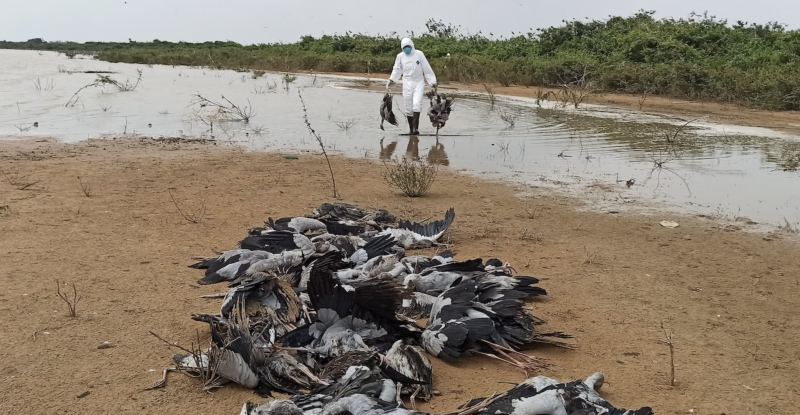
One Health in Action: What Wildlife Health Surveillance Can Tell Us About Pandemic Prevention
One Health Operations
Western Pacific Region
Cambodia
When animals become sick or die in the wild, it is not just nature that is at risk – 75% of emerging infections in humans are transmitted from animals. Diseases like COVID-19, SARS, and avian influenza have shown us how a virus can jump from animals to people and trigger a global crisis. With climate change effects on the rise, the emergence and spread of infectious diseases is only increasing.
Advancing global health security hinges on strengthening the connection and collaboration between the human and animal health sectors. WHO partners with international organizations and national animal health institutions to improve rapid detection of emerging pathogens and ensure a fast, coordinated response to outbreaks. This integrated effort aligns with the One Health approach, which emphasizes the interconnectedness of human, animal, and environmental health for more effective prevention and control strategies.
Since 2022, with support from USAID, WHO has partnered with the Wildlife Conservation Society (WCS) in Cambodia to support the country to strengthen surveillance capacities to detect early signs of dangerous diseases in wildlife. This includes bolstering of the Wildlife Health Surveillance Network, improved reporting of wildlife sickness and mortality events, the Standard Operating Procedure for Wildlife Health Surveillance being adopted into national policy, and the introduction of innovative tools in protected areas to track wildlife health. In this Q&A, you will hear from Dr Emily Denstedt, a WCS Regional Technical Advisor, and Mr Sokha Chea, a WCS Project Manager from Cambodia, on how the wildlife health surveillance system helps shift the focus from reacting to outbreaks to preventing them.
- With the world still recovering from the COVID-19 pandemic, how does wildlife health surveillance in Cambodia help us stay ahead of the next pandemic?
Dr Emily Denstedt: Wildlife health surveillance systems are crucial for early detection and management of emerging infectious diseases and other non-infectious health threats, which can have profound implications for human health, livestock health, and biodiversity. H5N1 (avian influenza), for example, has devastated wild birds, mammals, and domestic animal populations worldwide and threatens to become the next global pandemic in humans. It is imperative to detect and track these pathogens with vigilance. Wildlife health surveillance systems enable monitoring of wildlife populations, facilitating timely interventions that can prevent zoonotic spillover events and protect wildlife populations.
Cambodia has demonstrated One Health in action over the last several years while facing major H5N1 outbreaks in domestic and wild birds and multiple spillover events into humans simultaneously. With Standard Operating Procedures for Wildlife Health Surveillance implemented now at a national level, the environmental sector can respond to unusual events reported in wildlife with their public and domestic animal health counterparts. Preparing and responding to wildlife health events in this way helps Cambodia get in front of concerning events with pandemic potential to form risk assessments and guide policy decisions while keeping communities safe and healthy.
- When animals die in the wild, what steps are taken to figure out if it’s something dangerous? And how do these steps help in detecting high-threat pathogens early?
Dr Emily Denstedt: An investigation is typically triggered by a report of an unusual event involving one or more sick or dead wild animals. The key to receiving these reports is to have trained individuals on the ground – they are often rangers patrolling a protected area. Once that initial detection and report is made, technical support can be mobilized through an investigation, laboratory testing of samples, and data analysis.
In Cambodia, environmental stewards like rangers and conservation experts are crucial to monitoring wildlife health and detecting disease events in wildlife, including outbreaks of avian influenza in Cambodia’s threatened waterbird colonies. Rangers and other environmental officials across the country are now trained in effective and safe monitoring, reporting, and sampling of any sick and dead wildlife. Without them, several of these extremely concerning health events in wildlife would have never been detected.
- You’ve been involved in the recent implementation of wildlife health surveillance in Cambodia. What successes have you seen so far, and what challenges still lie ahead?
Mr Sokha Chea: After nearly a decade of commitment, the Wildlife Health Surveillance Network (WHSN) has now expanded to cover more wildlife habitat sites nationwide. Led by government agencies with support from partners, this network has developed and endorsed Standard Operating Procedures for implementation in Cambodia. Through WHSN, we can detect diseases like Lumpy Skin Disease in wild ungulates, African Swine Fever in wild boars and wildlife poisoning cases. Notably, WHSN has consistently detected avian influenza in wild birds over the past five years, thanks to collaboration across the national, sub-national, and community levels.
While long-term sustainability of WHSN is uncertain due to funding challenges, the WHSN Working Group is committed to maintaining the network. We have seen resilience within WHSN’s institutions, with some stepping up to offer free sample testing and field equipment donations to support operations.